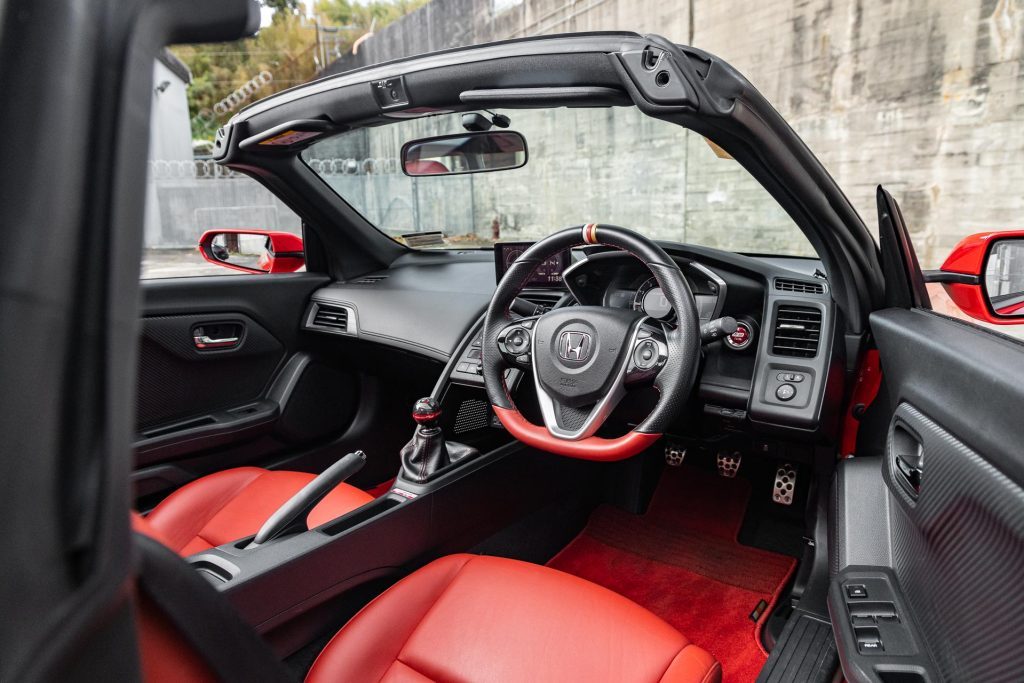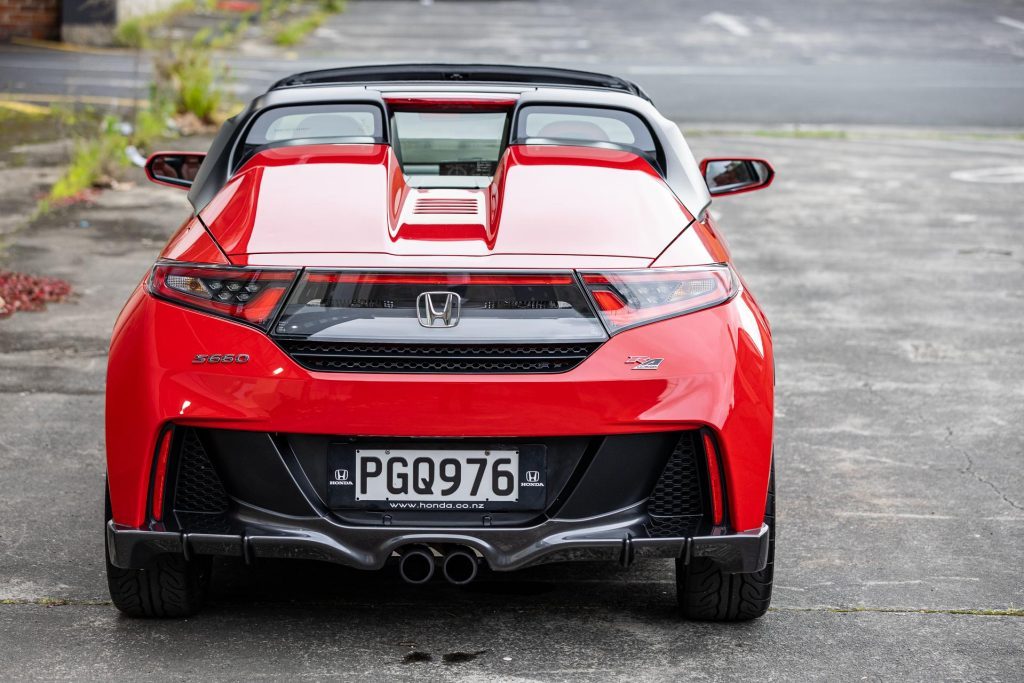2017 Honda S660 Mugen RA
Words: Kyle Cassidy | Photos: Isaac Western
The S660 channels Honda’s commitment to its sporting heritage. It’s from a long line of dynamic heroes, and is one that proves you don’t need a big donk to thrill.
Honda’s first car was a sports machine, the concept Sports 360 debuting in 1962. This small convertible ran a 356cc, DOHC inline four developed using knowhow from Honda’s motorcycle racing exploits.
This was also the year that Honda opened its Suzuka Circuit, Japan’s first race track. Sport is in Honda’s DNA.

While Honda’s first production four wheeler was the Honda T360 small pickup truck, its first car was the S500, the production reality of the Sports 360.
It went on sale in 1963. Like the 360, the 500 had a dohc four cylinder engine but with a larger 531cc displacement. With four carburetors and a 9500rpm rev ceiling, it was good for 33kW at 8000rpm.
Company founder, Soichiro Honda is famous for saying; “If Honda does not race, there is no Honda. Racing improves the breed.”

It wasn’t long after the S500’s debut that Honda was lining up on the Formula 1 grid, the RA271 entering the German GP in 1964.
Honda has a long held belief ‘that racing is an ideal training ground for engineers’ helping quicken the pace of development.
Honda’s race machines are largely developed in-house, rather than contracted out, as this helps the development of its engineers.

Honda says this sports DNA is part of every car the brand offers. These sentiments are said to ‘remain a driving force behind the Honda brand’.
The most obvious realisation of this currently is the Civic Type R, the best of the hot hatch breed.
However, Honda’s sport DNA is inherent in all of its products with components like its dual pinion steering giving its cars more desirable handling characteristics.

The steering feel and precision of a Honda helm comes from the separation of the driver’s input into the steering (that’s one pinion) and the powered assistance provided by the electric motor (the other pinion).
This lends it more precise control and a natural, responsive feel. Honda’s Amplitude Reactive Dampers help with a mix of refinement and precision.
These have variable damping forces based on your speed and bumps of the road. It’s soft over the small bumps to improve ride but as the inputs increase, the damping forces do too, aiding stability and control.

Honda’s heritage is dotted with sports offerings; the S cars from the sixties, CR-X and Prelude in the 80s and the Type Rs and the NSX of the nineties and 2000s.
Its S line of cars made a comeback with the S2000 in 1999 while this little ripper, the S660, was made from 2015 to 2022.
Though only offered new in Japan, a few of these Kei car heroes have made their way here as imports.

To recap, Kei cars are limited to an engine no larger than 660cc with a 47kW cap on power. To ease parking and congestion woes, a Kei car must fit within a 3.40m by 1.48m footprint.
The S660 channels the spirit of the Beat from 1991, another convertible Kei car and consequently the last Honda to be signed off by Soichiro Honda before his death.
Designed with sports in mind, the S660 uses a unique monocoque chassis with independent mac struts front and rear, with a rear aluminium subframe adding stiffness for dynamic stability.

Power, or at least motivation, comes from the S07A 660cc, turbocharged DOHC three-cylinder engine kicking out the prescribed 47kW and 104Nm of torque.
While it’s no powerhouse, weight is a key contributor to the S660’s lively nature, it being just 830kg.
This particular 2017 S660 is a special Mugen RA edition, limited to 660 units. The Mugen brand was created in 1973 by Soichiro Honda’s son, Hirotoshi, and offers a range of performance- and style-enhancing features for all Honda models to this day.

The Mugen S660 has a few carbon fibre exterior add-ons, there’s a twin-pipe sports exhaust and forged BBS aluminium wheels. It also gets retuned suspension featuring adjustable Bilstein dampers.
Inside there are the red leather seats and a leather bound steering with a mark at the 12 o’clock.
A Mugen start button fires up the action, there is a serial number plate (this one being #332) and carbon-fibre trim pieces including the gear knob atop the six-speed manual. The S660 can also be had with a CVT auto, but that wouldn’t be much fun.

The S660 is comically small, it is actually under the Kei car size limit making it a truly minuscule Mugen machine. The interior is intimate.
It’s not so bad getting in with the roof in place (much easier with it removed though), and once seated there’s reasonable room behind the wheel.
You wouldn’t, however, want to be too much taller than six foot; our heads kept bouncing off the roll hoop in behind the seats.

Apart from the Mugen add ons, most other cabin bits are black and plastic in nature. The instruments are minimal and perfect, the digital speed readout sitting inside the centre of the analogue tacho.
This is flanked by the fuel gauge, which hardly moves given the 4.1L/110km fuel consumption number.
The S660 runs a targa top configuration, a canvas roof covering the cabin. Its removal is a manual operation with two levers on each side unclipping it and then you simply lift it off.
You then roll it up and place it in the box under the front bonnet. This receptacle is only just big for the roof, meaning the S660 has zero luggage capacity. No worries, however, as it’s all about the drive.


The S660’s engine might be small in stature, but it has a big character. It thrums away right behind you while Honda has placed a third retractable window in between the roll hoops.
This helps deflect a bit of wind when the roof is off, or you can lower it to let more of the S07A’s noise into the cabin. Honda also positioned the intake right behind the driver’s head to optimise the sound experience.
This is further improved here with an HKS pod filter. Honda concentrated on the exhaust and blow off noise too, the latter a mid-nineties, JDM fanboy’s dream.

Along with the enhanced shoooosh of the induction, there’s an explosive fif-pssh of spent boost everytime you back off the gas.
The S660 pootels about in traffic okay, shifting around the 4000rpm mark. Though it’s light, the torque count is small, so you do need to row it along, the best pull coming from 3000rpm.
Further afield, it will happily wind out to 7700rpm, spinning freely to the heights.



Come time to pluck another ratio, the short throw manual obliges, each shift precise and sweet. There’s no muscle required to wrench it around the gates, it flows easily.
That’s a blessing of the mighty mouse powertrain; the components don’t need to be bulky to endure the strain of an excess of power.
The gears one to five are closely stacked to keep the 660 spinning, each cog dropping the engine back from redline to around 4500rpm.
And unlike most modern rockets that quickly run illegal before the top of second gear, here you can rip through second, third and almost reach the redline in fourth and still be legal (on the expressway at least).

Sixth is said to offer added comfort when cruising but the triple is still buzzing above 3000rpm at 100km/h.
While it’s a lithe little jigger, the controls are not overly light, the steering with some weight and life, and the clutch pedal with a decent feel too.
Progress can get a bit bumpy on its abbreviated wheelbase, the Bilstiens more concerned with control than ride comfort, but neither is it harsh.

There is an excess of grip, the S660 rolling on specially developed Yokohama Advan Neova rubber, complete with a racy semi-slick tread pattern.
Measuring 195/45R16 on the rear, the engine’s torque will never overwhelm them. The 165/55 15s on the front aid the turn in, and this has a grip aplenty.
Stability is enhanced by Honda’s Agile Handling Assist using the brakes to tighten cornering lines, and with its well balanced, minimal mass, it blazes through the corners.


The steering is a lively character, buzzing with road feel, both good and bad, snagging the odd bump in the bend.
The brake discs might only measure up at 260mm front and rear, but they haul this up soundly, brake pedal feel being solid too.

This S660 is part of Honda NZ’s heritage collection, sitting proudly amongst the Type R, S2000 and NSX, highlighting the brand’s commitment to its sports DNA, no matter how big or small the package might be.
This article first appeared in the September 2024 issue of NZ Autocar Magazine.





